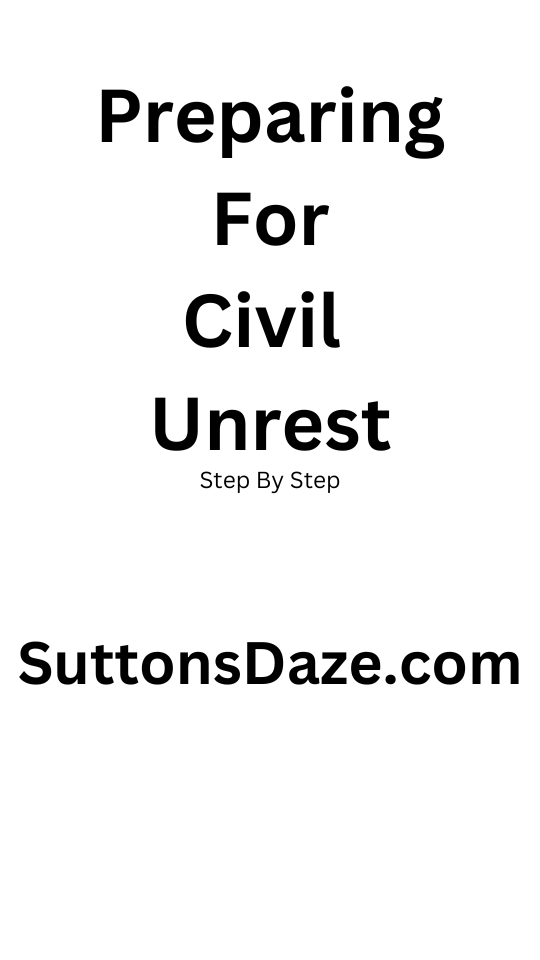Preparing For Civil Unrest
In a world where unpredictability has become the norm, preparing for potential civil unrest within a 100-day timeframe is not just a matter of prudence but of responsibility. While the thought of societal upheaval can be daunting, approaching the situation with calm and rational planning can make a significant difference in your safety and well-being. By focusing on essential supplies, personal safety, and situational awareness, you can navigate these uncertain times with confidence and clarity.
Stocking up on non-perishable foods, water, medical supplies, and personal hygiene products forms the foundation of your preparedness plan. It’s about ensuring you and your loved ones have the necessities to sustain yourselves in case of disruptions. Additionally, securing your home, maintaining communication devices, and having a financial safety net are crucial steps that fortify your ability to manage the unexpected. Remember, preparation is not about panic; it’s about empowering yourself to handle whatever comes your way.
Equally important is maintaining a heightened awareness of your surroundings and the evolving situation. Staying informed through reliable news sources, understanding local risks, and building a supportive network within your community are vital components of your readiness strategy. By adopting a proactive mindset and taking these preparatory steps, you can face potential civil unrest with a sense of preparedness and peace of mind, knowing that you have done everything possible to protect yourself and your loved ones.
Supplies to Stock Up On:
- Food and Water:
- Non-perishable foods (canned goods, freeze-dried meals, rice, beans)
- High-energy snacks (nuts, protein bars)
- Bottled water and water purification methods (filters, purification tablets)
- Medical Supplies:
- First aid kit (bandages, antiseptics, pain relievers, medical tape)
- Prescription medications (at least a 30-day supply)
- Over-the-counter medications (allergy meds, cold medicine, anti-diarrheal)
- Personal Hygiene Products:
- Toilet paper, wet wipes
- Soap, hand sanitizer
- Feminine hygiene products
- Personal Safety Gear:
- Protective clothing (gloves, masks)
- Fire extinguishers
- Self-defense items (pepper spray, personal alarms)
- Communication Devices:
- Battery-operated or hand-crank radio
- Extra batteries or power banks for phones
- Two-way radios or walkie-talkies
Preparation Steps:
- Home Security:
- Reinforce doors and windows
- Install security cameras and motion sensor lights
- Develop a family emergency plan and conduct drills
- Financial Preparedness:
- Have cash on hand (small bills)
- Important documents (IDs, insurance policies) in a fireproof safe
- Backup important data digitally
- Transportation:
- Keep vehicles fueled and in good repair
- Emergency vehicle kit (jumper cables, spare tire, tools)
- Maps and alternative routes planned
- Shelter and Warmth:
- Extra blankets, sleeping bags
- Portable heater or hand warmers
- Tent or temporary shelter materials
- Cooking and Lighting:
- Portable stove or grill with fuel
- Matches, lighters, and fire starters
- Flashlights, lanterns, and candles
Situational Awareness:
- Monitor News and Alerts:
- Subscribe to local news and emergency alerts
- Follow reliable sources on social media
- Join neighborhood watch or community groups
- Understand Local Risks:
- Know the potential hotspots for unrest
- Be aware of evacuation routes and shelter locations
- Understand the local law enforcement and emergency services’ plans
- Network and Community:
- Build relationships with neighbors for mutual support
- Share information and resources within your community
- Establish a communication tree for quick updates
- Mental and Emotional Preparedness:
- Stay informed but avoid panic-inducing news
- Practice stress-relief techniques (meditation, exercise)
- Maintain routines to provide a sense of normalcy
- Plan for Long-term Disruptions:
- Consider sustainable food sources (gardening, local farms)
- Learn basic survival skills (first aid, self-defense, fire-starting)
- Be ready for potential long-term changes in your daily life




